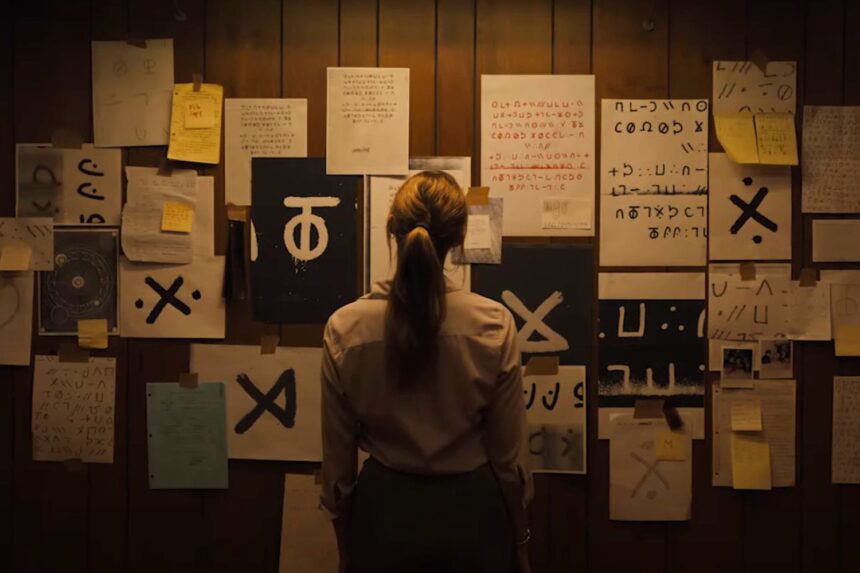(Scene of Maika Monroe in Longlegs)
When Longlegs, the Satanic horror thriller from writer-director Osgood Perkins, arrived in theaters in July 2024, many critics lauded it as the scariest movie of the year, even of the decade. But in a year that has seen record amounts of anti-trans legislation, the deaths of two pregnant women in Texas due to the state’s anti-abortion laws, and racist lies about Haitian immigrants stealing and sacrificing pets in Springfield, Ohio, I find Hollywood Satanism far less frightening than real-life Christian violence, and Longlegs notable not for its horror, but for the humor with which it skewers Christian conspiracy myths of evil.
As David Frankfurter points out in his book Evil Incarnate: Rumors of Demonic Conspiracy and Satanic Abuse in History, cultures from the ancient Roman Empire to 20th century Africa have believed in secret evil sects that ritualistically torture, cannibalize, and sacrifice children, often leading to violent scapegoating of vulnerable individuals. A Christian iteration of this myth swept the United States during the Satanic panic of the 1980s. Media, politicians, social workers, and law enforcement promoted the belief that Satanic cultists had infiltrated preschools and daycare centers and subjected children to Satanic ritual abuse (SRA) involving cannibalism, sacrilege, animal sacrifice, and sexual molestation. By 1994, 12,000 claims of SRA had been made, none of them substantiated. Queer people especially suffered, with four lesbian women in San Antonio and a gay 19-year-old teacher’s aide in Massachusetts falsely convicted of child sexual abuse. Some defendants accused of SRA, like New Jersey day care teacher Kelly Michaels, concealed same-sex relationships from juries even when it made their defense more difficult, given the erroneous cultural association of linking queerness with child abuse.
The panic had quieted by the mid-1990s, but many of its tropes resurfaced in 2017 with the QAnon conspiracy, which claimed Democratic politicians and Hollywood celebrities belonged to a cabal of Satanic pedophiles. A social media crackdown on QAnon-promoting accounts followed the January 6, 2021 U.S. Capitol attack, but the movement appears to have had a direct influence on paranoid right-wing narratives around LGBTQ “grooming” in public classrooms. Florida Governor Ron DeSantis’ press secretary Christina Pushaw framed his controversial 2022 “Don’t Say Gay” curriculum law as an “Anti-Grooming Bill,” and extremist websites like Patriot.win and news outlets like Fox News have accused parents and teachers who seek to validate trans children’s identities of being pedophiles.
Clearly, Christian myths of evil conspiracy have had a pervasive and damaging effect on our politics. Yet the entertainment industry often reifies these myths in religious horror movies. Frankfurter theorizes that evil conspiracy myths arise when globalizing cultures, such as the Roman Empire, the Catholic church, or late capitalism, subsume local religious worlds, reinterpreting local experiences of suffering and misfortune within the framework of demonology. Codified in text, these demonologies become sources of authority for individuals entrusted with discerning and expunging evil. Satanic horror movies from The Exorcist to The Conjuring have perpetuated this myth for modern America, pitting heroic authorities—from Catholic priests to freelance occult investigators—against demonic forces.
At first, Longlegs seems as though it will follow this template. Clairvoyant FBI Agent Lee Harker (Maika Monroe) is assigned to investigate a mysterious, decades-long crime spree in which fathers are driven to kill their families and themselves. The mastermind behind the crimes leaves an occult-coded note at each scene, signed “Longlegs.” Through research and supernatural intuition, Harker unravels Longlegs’ identity: a freakish-looking, devil-worshipping, failed glam rocker named Dale Ferdinand Cobble (Nicholas Cage), who drives fathers to kill with black magic-infused dolls.
With her investigative prowess and stoic resolve, Harker at first seems to embody the archetype of expert “discerner of evil.” During the 1980s Satanic panic, such “experts” derived their authority from both secular and spiritual credentials. Evangelical and Catholic charismatic police officers—“cult cops”—claimed the ability to sense the presence of demons, while social workers and psychiatrists claimed expertise through “cursory research in old books on Devil-worship and human sacrifice,” recovered memory therapy techniques, and claims of firsthand victimization by Satanic cultists. Harker possesses many of these credentials: an FBI badge, apparent psychic gifts, familiarity with Biblical scripture and occult books, and firsthand victimization by Cobble, the memory of which she recovers late in the film, in a manner reminiscent of recovered memory therapy.
But in a grimly ironic twist, the movie denies the efficacy of any of these credentials. Harker discovers her outwardly pious mother is an accomplice to Cobble, and she is forced to kill her, while Cobble, who committed suicide to escape punishment, taunts her from beyond the grave, hinting that Satan has rewarded his crimes with immortality. Satan is not a cosmic combatant against God, but an omnipresent trickster spirit whose senseless cruelties cannot be averted by any authority, secular or religious. It is a nihilistic vision, but also a bitterly humorous one, satirizing the false comfort of Satanic panic narratives—the comfort of attributing suffering, including suffering inflicted by sacrosanct institutions like church, state, and family, to an organized conspiracy that can be identified and destroyed.
This subversive humor can also be found in Nicholas Cage’s performance. Frankfurter describes how myths of evil become “real” through the performances of individuals “who act ‘as if’ a Satanic or witch-conspiracy and its core atrocities were actually tangible”—the exorcist-priest performing an exorcism, or the possessed person performing possession—and that such performances inevitably veer into parody: “…the mimetic performance of evil is always parody—critique or caricature—in some sense, because it must operate at a critical distance from the mythic roles it brings into public presence. Distortion, exaggeration, and sometimes even comedy occur in the space of that distance.”

(Nicholas Cage in Longlegs)
Nicholas Cage fans tend to expect some degree of distortion, exaggeration, and comedy in his performances, and his turn as Cobble does not disappoint. Though the character unsettles with his powdered, plastic surgery-ruined face, wheedling voice, and creepy fixation with the “birthday” of any female character, Cage’s mannerisms often caused me to laugh out loud in the theater. While driving in silence down an ominous road through the woods, Cobble abruptly shrieks “Mommy! Daddy! Unmake me, and save me from the hell of living!” at the top of his lungs. The sentiment might be disturbing, but Cage exaggerates the volume and inflection to such an extent that it nearly breaks the fourth wall. In a flashback scene, Lee’s mother confronts Cobble for speaking to a young Lee, demanding to know who he is and what he wants with her daughter. Cage silently and dramatically holds up his hands, performing a series of slow, exaggerated, Tai Chi-like gestures before unexpectedly bursting into song. His lyrics are a chilling, cryptic message of warning, but his bizarre movements and affected vocals inspire laughter. And later, when Harker interrogates an arrested Cobble, Cage contorts and spins in his chair, as though attempting a possessed Linda Blair impression, then menacingly leans forward, adopting self-consciously “scary” voices as he delivers a vaguely sinister word-salad, concluding with a campy “Hail Satan.”
Far from just another hyperbolic display of Cage rage, these excesses arise from Cage performing as an awkward, isolated human character, Cobble, who is in turn seeking to “perform” the mythic role of Satanic killer. In his hideaway in the basement of Lee’s childhood home, we see Cobble engaged in Satanic dollmaking while surrounded by posters of T. Rex and Lou Reed, hinting at his loneliness and failed dreams while also recalling the Satanic panic’s association of rock music with demonic evil. By exaggerating Christian stereotypes of evil—changing voices, wild gesticulations, popular music as a gateway to Satanic crimes—Cage makes those stereotypes seem ridiculous, introducing a level of “critical distance” between the audience and the myth his character seeks to embody, thus making space for parodic humor.
Even so, for all its subversive elements, Longlegs’ conception of evil is disappointingly similar to that found in modern Christian conspiracy myths, from the 1980s panic to the current “groomer” fixation. As in these myths, Longlegs locates the source of evil not within social structures like the nuclear family, patriarchy, or capitalism, but in an omnipresent, irredeemably evil Other. Christian fathers kill their wives and daughters, but these crimes are ascribed to Satan, embodied by a deviant social outsider. The movie’s parodic humor therefore fails to subvert Christian myths of evil. Rather, it reshapes and revitalizes those myths for a disillusioned, secular modern audience.
Such a critique might seem unfairly burdensome for an escapist horror movie, but horror movies have played a considerable role in shaping modern American Christian conceptions of evil. In his book American Exorcism: Expelling Demons in the Land of Plenty, Michael W. Cuneo points out that demand for exorcisms increased dramatically after the 1970s, which saw the runaway success of films like The Exorcist and books like Malachi Martin’s Hostage to the Devil. Such media influenced representations of the demonic are found in bestselling Satanic ritual abuse memoirs like Michelle Remembers and in the practices and beliefs of a wide range of Christian denominations. According to Cuneo, Catholic charismatic deliverance ministers Father Richard McAlear and Betty Brennan created the practice of “binding spirits” to discourage the Exorcist-influenced performances of their demonically-assailed clients, which tended to involve a great deal of spitting, swearing, and vomiting.
At a time when the Religious Right continues to weaponize such myths of evil against vulnerable populations, including LGBTQ people, horror movies can offer resistance, combatting reactionary discourses of evil with humanistic ones. The psychological horror of Skinamarink, the 2022 feature debut by Canadian filmmaker Kyle Edward Ball, offers an example of what such resistance might look like.
Like Longlegs, Skinamarink is set in the 1990s while playing with 1970s aesthetics, the hazy analog cinematography recalling low-budget horror from the era. Two small children, Kevin and Kaylee, awake in the middle of the night to find their parents missing, and the doors, windows, and objects in their suburban house disappearing. A seemingly supernatural entity has invaded, and subjects the children to escalating physical and emotional torture. Just as in Longlegs, evil triumphs at the end; the children remain trapped within the entity’s clutches, with no understanding of what it is, how to escape, or why it’s claimed them.

(Scene from Skinamarink)
Although the trope of a suburban home possessed by supernatural evil is familiar to the point of cliché, the film complicates the supernatural by depicting it as a psychological reality, rather than a literal one. An opening title card dating the movie to “1995,” coupled with murky visuals, shot from the children’s point of view, suggest a childhood nightmare recalled as an adult. In an early scene, their father mentions on a phone call that Kevin has hurt his head by “falling down the stairs,” leaving open the possibility that the ensuing dreamlike sequence of events expresses a fearful, injured, possibly abused child’s psyche.
The movie makes no references to religion. But the situation—two innocent children condemned to a loop of infinite torture for no discernible reason—reminded me of nothing so much as conceptions of hell, ancient and modern, from St. Augustine’s insistence on the damnation of unbaptized infants to infernally-obsessed denominations like the Westboro Baptist Church and Catholic Traditionalism. By grounding its vision of hell in the psyche rather than in an external, objective realm, the movie not only confronts audiences with the horror of that vision, but raises questions as to how it could come to exist in a child’s mind at all, forcing audiences to reckon with hell as a concept shaped by cultural discourses of evil, rather than
Source link




